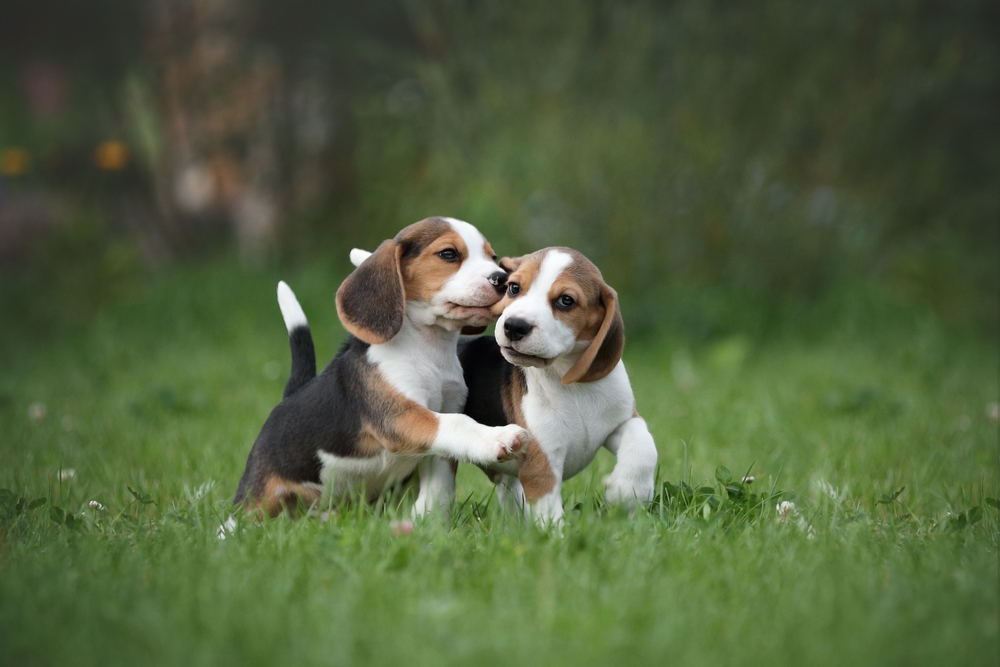In this article
Dogs love to play, and every dog seemingly has their own style. My dog, Tula, lies down until the other dog approaches and then barks and wrestles with them. It can be a bit much for some dogs, but others will wrestle with her.
Sometimes, canines have play styles that match the purpose and characteristics of their breed, though some base their preferred method of play on interactions they have had with other dogs and even their owners. Knowing how your dog plays can help you find suitable playmates and adapt your own games at home. It can also help you decide how to train and socialize your pup.
Here, we look at 10 of the most common play styles for dogs.

The 10 Dog Play Styles
1. Fighting

Undoubtedly, the most unsettling of the play styles is the fighting style. Dogs will push each other around, chase each other, and often rise and use their front paws to wrestle. There may be mouthing and quite a bit of noise. Although this type of play is acceptable with dogs that are comfortable with it, it can cause anxiety in other dogs, and it shouldn’t be encouraged with people.
Look for other ways to play with a fighter, such as a tug rope or a stuffed toy that they can safely tear up. When your dog is wrestling with other dogs in the park, look for signs of biting and other potentially aggressive actions. Play fighting can escalate into real fighting, so it should be carefully monitored. If the dogs’ body language changes from bouncy, wiggly movements to stiff and rigid ones, it is time to call your dog away.
Sporting breeds like Labradors commonly display this type of play style, but it can also be common in pets whose owners encouraged wrestling when they were puppies.
2. Independent Play

While a lot of dogs enjoy playing in groups, some prefer their own company. Independent players will sit outside the group and away from other dogs while having their own fun. This is especially common in hounds and hunting dogs that were bred to work independently, such as Dachshunds.
At the park, your independent player will enjoy wandering off, away from the crowd, and at home, they will likely prefer interactive toys like squeaky toys or puzzles to tug toys.
3. Chase

We’ve all seen dogs in the park that spend hours chasing after a tennis ball or a frisbee, typically either dropping it or retrieving it so their human can throw it again. Some dogs like to be chased, finding fun in running away from other dogs or their humans. Many enjoy chasing after lures or flirt poles, as it simulates hunting, chasing, and catching in an acceptable manner.
Many working breeds enjoy chasing style games because they often have a high prey drive. Ensure that your pup takes a break from chasing, though, so they don’t over-do it, especially on hot days.
4. Noisemaking

Some dogs prefer to join in vocally, rather than physically. They will stand at the edge of a game and seem to bark instructions or encouragement at the participants. These noisemakers tend to be herders, and they are attempting to do their job of controlling the herd. They can become quite frustrated if the herd doesn’t listen.
Most dogs don’t mind the noisemaker, but they can be a nuisance at home if they constantly bark while you’re trying to initiate a game of tug. It can be very difficult to encourage the participation of a noisemaker, but if yours is a herding dog, it might be worth trying to throw a ball or even try your hand at some herding games.
5. Tugging

Tug is a game that is typically enjoyed by the working dogs of the canine world. German Shepherds, Malinois, and Terriers love nothing more than getting their teeth on a rope or toy and attempting to take it from their owner.
Tuggers can cause a bit of a problem with other dogs, which will view their games as an affront to their toy ownership rights. But if they find another tugger, the game can continue for hours with just the occasional break to give their jaws a rest.
Tug is a good game to distract dogs and puppies from chewing hands and arms, so it isn’t just working dogs that can adopt this playstyle. At home, make sure you choose a toy that won’t shred or break apart easily, or your dog could end up ingesting the pieces and causing them some problems.
6. Full-Contact Play

Full-contact play is similar to fighting in that the dog can use their front paws, rear paws, or even their whole body. It generally involves the full-contact player running straight at other dogs, potentially bowling them over. They often partake in body slamming their intended playmate. It can be somewhat offensive to dogs that aren’t familiar with the play style and may lead to accidents involving people of all ages.
If you come across another dog that isn’t comfortable with this style of play, ensure that your pup is on a leash and encourage other types of play. You will also want to discourage this type of play with people, or you’ll always have to help your guests get back on their feet.
7. Soft-Touch Play

Sometimes referred to as cat play, soft-touch play is generally reserved for quiet dogs but may also be adopted by herding breeds. As the name suggests, it involves the dog gently touching their playmate. It involves a lot of sniffing and nosing and may incorporate some nudging.
Although it is an inoffensive play style, it can lead to the dog in question being overwhelmed by more boisterous dogs. At home, the soft-touch player might prefer love and attention, but you can also use interactive toys and potentially even try tug or fetch.
8. People Play

While some dogs love nothing more than playing with their kind, others prefer the company and play of humans. If your dog ignores other dogs at the dog park and approaches their owners instead, you have a people dog.
Companion breeds can fall into this category, but so can dogs that have spent a lot more time around groups of people than around canine companions. There is nothing inherently wrong with dogs that prefer to play with people, but you will need to ensure that they are well-socialized and that they have been trained not to jump up at everybody they meet, or they can become nuisances.
9. Herding

It can be fascinating and amusing to watch herding dogs performing their magic on people or other dogs at the park, especially when the objects of the herding are unaware.
Herding dogs have a host of skills and tactics that they use to try to gather up their quarry. Some will encourage through their placement and movement. Others will bark. Heelers will attempt to nip at the heels of their targets.
Although herding can be amusing, if your herder feels their instructions aren’t being listened to, they can get frustrated. If they use heel nipping as a method of herding, that should be discouraged through good training.
10. Running

Some dogs just love to run. They will dart back and forth, run from person to person, or completely ignore people and other dogs and just run around. Dogs like Collies that have tons of stamina are prone to this kind of behavior, which in itself isn’t bad.
Running can be a problem if your dog has poor recall, though, so you will need to work on the “come” command and make sure you can get your dog back whenever you need to. If you’re successful, this is a good way to tire out high-energy dogs.

Frequently Asked Questions (FAQ)
Is It Normal for Dogs to Bite Each Other When Playing?
There is a difference between play biting and proper biting. Play biting is essentially mouthing, and while it mimics the action of biting, it isn’t aggressive. It can be a problem if the other dog doesn’t recognize it as play, however, and sharp teeth and strong jaws mean that even play bites can be painful to other dogs and people.
You can discourage biting with distraction techniques and use positive reinforcement to encourage other play habits. Your veterinarian can advise you on these techniques.
If you need to speak with a vet but can't get to one, head over to PangoVet. It's an online service where you can talk to a vet online and get the personalized advice you need for your pet — all at an affordable price!

Should I Let My Dog Play Fight?
Play fighting is fine, as long as it isn’t causing injury or anxiety to the other dog or person playing. Generally, though, encouraging play fighting with humans is bad, as your pet will see other people as being potential playmates. Not everybody wants to or can handle play fighting with dogs. Try to encourage playing with a stuffed toy or another safe toy instead.
How Long Should Dogs Play For?
Depending on breed, age, and general condition, dogs need anywhere from 30 minutes to 2 hours of exercise a day. This includes walks but can also include playtime and other forms of exercise.
Try to keep play sessions relatively short to avoid overstimulation, and if your dog is playing with another dog, make sure they take a break when the other participant has had enough.

How Can I Tell If My Dog Is Playing or Being Aggressive?
Playful dogs will usually have a relaxed posture and be bouncy, whereas an aggressive dog will be stiff and rigid. Snarling and the bearing of teeth are also signs that a dog is being or becoming aggressive, and these should be taken as an indicator to stop playing and do something else.

Conclusion
Most dogs love to play, but every dog has their preferred type of play, ranging from the independent player to the pack herder. Some make a lot of noise, while others are silent. Some get very physical with their playmates, while others are soft players.
While play style can partially be determined by breed type, this isn’t always the case, as a dog’s history and training also play a significant role. Try to find healthy outlets for your dog’s preferred style of play, enabling them to enjoy physical exercise and mental stimulation in a controlled, safe environment.
Featured Image Credit: mountaintreks, Shutterstock



















